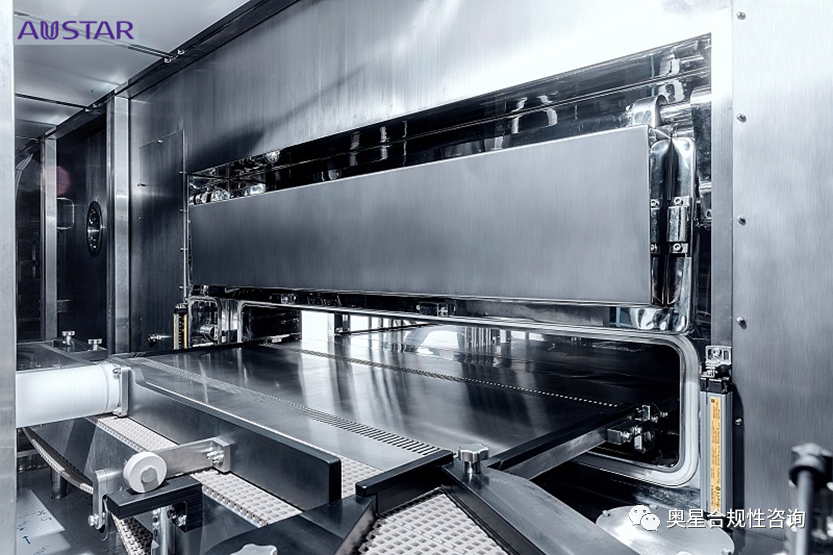Yossi Shapira AUSTAR Consultant
附录1建议无菌工艺的污染控制策略(CCS)要形成文件、设计、制定并实施。只有经验丰富的工程公司,将经验丰富的工艺工程师、冻干专家、微生物学家和无菌技术专家的技能结合起来,才能应对新的极端挑战要求,特别是SVP(小容量注射液)的冻干。
Annex 1 recommends lyophilization technology as an extension of aseptic processing of the sterile product. Therefore, lyophilization and its allied activities are considered critical process steps: extra handling, extra time exposure to contamination, long process, extreme functioning conditions, makes products higher sensitive to particulate, endotoxin, and microbial contamination, but lower possibilities for detection compared to the regular aseptic filling process. Higher attention and process CCS is required, products quality must be built and documented within its process. Drugs manufacturers are responsible to implement Annex 1 strategy in its plants.
附录1 建议将冻干技术作为无菌产品的无菌处理工艺的延伸。因此,冻干及其相关活动被认为是关键工艺步骤:额外的处理,额外暴露于污染的时间,长时间的处理,极端运行条件,使产品更易于受到微粒、内毒素和微生物污染,但相对于常规的无菌灌装工艺具有更低的检出可能性。需要更多的关注和工艺CCS,在此过程中必须实现产品质量并进行记录。药品制造商负责在其工厂实施附录1的策略。

CCS assessment simulation and validation are required, ensuring prevention of particles, microbial and endotoxins contamination The CCS is based on the QRM (Quality Risk Management) the company’s in-house CCS policy, defined in line with the needs of the developed sterile products and the features of equipment and facilities must fit these requirements. It is required that manufacturer CCS shall be risk reviewed periodically, to ensure the consistent, repeatable assurance of the sterile lyophilized products by the entire system.
需要进行CCS 评估模拟和验证,确保防止微粒、微生物和内毒素污染。CCS基于QRM (质量风险管理),公司的内部CCS政策根据开发的无菌产品的需求进行定义,设备和设施的特性必须符合这些要求。要求制造商CCS应定期进行风险评估,确保整个系统对无菌冻干产品具有一致可重现的保证。

lyophilizer and its utensils sterilization, it holding, and its handling should be designed (in addition to the preloaded product aseptic handling, while filling). Sterilization frequency will be assessed according to the risk to system contamination while use. Manually loaded, non-barriered lyophilizers are in special contamination risk therefore, lyophilizer’s sterilization cycle prior to each cycle loading is recommended.
冻干机及其用具的灭菌、保存和处理应进行设计(除了灌装过程中预装载产品的无菌处理)。灭菌频率根据系统使用过程中的污染风险进行评估。手动装载的无屏障冻干机具有特殊的污染风险,因此,建议在每个循环装载之前对冻干机进行灭菌循环。

Lyophilizers'vials transfer, loading and unloading systems should be designed to minimize human intervention.When isolated Automatic Loading Unloading System is used,sterilization frequency should be justified and documented as part of CCS. Cleaning process is recommended after unloading,prior to any sterilization process.
冻干机的小瓶转移,装载和卸载系统的设计应尽量减少人为干预。当使用隔离的自动装卸系统时,灭菌频率应合理论证并作为CCS的一部分进行记录。建议在卸载后,灭菌工艺之前进行清洁。


Lyophilizer are constructed of Stainless Steel. It function in extreme temperatures from deep freezing of -85°C to sterilization temperature of +125°C, from nearly absolute vacuum to sterilization pressure of 2.5 bars. While functioning within these extreme conditions, lyophilizer’s structure is thermally stressed. Therefore lyophilizer’s structure and its vent filters integrity should be tested following any sterilization and during lyophilization. Proper structure and integrity will prevent external contamination. Testing results should be documented as part of batch release documents. Maximal allowed air leakage value should be verified prior to each lyophilization cycle.
冻干机的材质为不锈钢。可在-85°C低温冷冻到+125°C灭菌温度的极端温度,以及接近绝对真空到2.5 bar的灭菌压力下运行。在这样的极端条件下运行时,冻干机的结构可耐热应力。因此,冻干机的结构及其通风过滤器的完整性应在任何灭菌后以及冻干过程中进行测试。适当的结构和完整性会防止外部污染。测试结果应进行记录,作为批放行文件的一部分。最大允许空气泄漏值应在每个冻干循环前进行确认。

Lyophilization trays and shelves flatness should be checked to verify it is not deformed: for heat transfer purpose and possible miss- stoppering identification.
应检查冻干托盘和板层的平整度以确认其是否变形:避免传热不好并识别可能的压塞缺失。

Loading pattern, partial loads should be specified validated and documented.
装载形式,非满载装料应进行规定、验证和记录。

Handling of opened /semi-opened vials should be done in grade A condition. All sorts of LAF protection and automation systems should be used for eliminating human intervention frequency. Semi opened vials staging zone will be in grade A condition.
未压塞/半压塞小瓶的处理应在A级环境下进行。应使用各种层流保护和自动化系统消除人为干预频率。半压塞小瓶暂存区将处于A级环境。


Loading pattern, partial loads should be specified validated and documented.
装载形式,非满载装料应进行规定、验证和记录。

Utilities design, including in-process controls positions and relevant technology with no human intervention should use state of the art design.
公用设施设计,包括过程控制位置和无人为干预的相关技术,应采用最先进的设计。

For lyophilization process, product containers and closures selection must fit the freeze drying thermal stress conditions, minimizing breaks/cracks.
冻干工艺,产品容器和密封件的选择必须符合冷冻干燥热应力条件,尽量减少破裂/损坏。

Justified vendors selecting especially for aseptic technique and lyophilization equipment and approval – such as key constructors validators and component suppliers.
合格供应商,特别是无菌技术和冻干设备供应商的选择和批准,如关键施工验证人员和部件供应商。

Management and validation of outsourced activities e.g. contract sterilisation services.
外包活动的管理和验证,例如合同灭菌服务。

Preventative maintenance performance and documentation – maintaining equipment, utilities and premises (planned and unplanned maintenance) to a standard that will ensure there is no additional risk of contamination.
预防性维护性能和文件 - 设备、公用设施和厂房(计划内和计划外维护)的维护标准是确保无额外污染风险。

Lyophilization – trends analysis, detailed investigation, root cause determination, corrective and preventive actions (CAPA) and the need for comprehensive investigational tools. Following continuous improvement based on information derived from the above.
冻干 – 趋势分析、详细调查、根本原因确定、纠正和预防措施(CAPA)以及对全面调查工具的需求。根据上述信息持续改进。

The manufacturing and control of lyophilized products requires detailed technical and process knowledge, well trained technicians and operators complex process technologies.
冻干产品的制造和控制需要详细的技术和工艺知识、训练有素的技术人员和操作人员,复杂的工艺技术。
Therefore each required process phase should be recorded and documented starting from:
因此,应从以下方面开始记录每个所需的工艺阶段:
Compounding, quality compounding attributes, and filtration data.
配制、配制质量属性及过滤数据。
Filling and loading, QBD, SPC and PAT records.
灌装和装载,QBD, SPC和PAT记录。
Filling environmental monitoring EM.
灌装环境监测EM。
Lyophilization and stoppering records.
冻干和压塞记录。
Unloading and crimping records.
卸载和轧盖记录。
Detailed 100% visual inspection, rejected categories and yield calculation.
详细的100%目视检查、剔除分类和产量计算。
Balance and units yield in each stage.
每个阶段的平衡和单位产量。
CIP record.
CIP记录。
SIP including all primary piping and valves records.
SIP包括所有主要管道和阀门记录。
Filter integrity test - FIT records.
过滤器完整性测试 – FIT记录。
Lyophilizer integrity test.
冻干机完整性测试。
Packaging records.
包装记录。
Balance of product and packaging materials.
产品和包材的平衡。
Analytical results.
分析结果。

Contamination Control Strategy (CCS) – A planned set of controls for cross contamination in the processing line, lyophilizer, environment exposure and controls, human hygiene protection, product protection: microorganisms, endotoxin/pyrogen and particles, derived from current product and process understanding that assures process performance, repeatability and product quality. The controls can include parameters and attributes related to active substance, excipient and drug product materials and components, facility and equipment operating conditions, in-process controls, finished product specifications, and the associated methods and frequency of monitoring and control.
污染控制策略(CCS)— 针对微生物、内毒素/热原和微粒的一系列有计划的控制措施,源于现有产品和工艺的理解并确保工艺性能和产品质量。控制措施可包括,原料药和制剂的物料和组分相关的参数和属性,厂房设施设备的操作条件,中间过程控制,成品质量标准,以及相关方法和监控频次。

Implementation of CCS for Lyophilization
According to the updated Annex 1 GMP requirements, the CCS for lyophilization is following summarized:
根据更新的附录1 GMP要求,冻干CCS总结如下:

The sterilisation of the lyophilizer and filling line associated equipment should be validated and sterilization frequency should be justified.
应验证冻干机和灌装线相关设备的灭菌,并合理论证灭菌频率。

The holding time between the sterilisation cycle and use should be appropriately challenged during aseptic process simulation (APS).
无菌工艺模拟(APS)过程中,灭菌循环和使用之间的保持时间应进行适当挑战。

Lyophilizers and associated product transfer and loading/unloading areas should be designed to minimize operator intervention.
冻干机及相关产品转移和装卸区域的设计应尽量减少操作人员的干预。

The sterilisation of the lyophilizer and filling line associated equipment should be validated and sterilization frequency should be justified.
应验证冻干机和灌装线相关设备的灭菌,并合理论证灭菌频率。

The lyophilizer chambers and condensers should be thoroughly cleaned, washed prior to sterilization.
冻干机箱体和冷凝器应在灭菌前彻底清洁和清洗。

Design and selection of loading and unloading method for the lyophilizer.
冻干机装卸方法的设计与选择。

The frequency of lyophilizer sterilization should be selected, risk assessed, justified and recorded.
冻干机灭菌的频率应进行选择,风险评估,论证并记录。
• Manual: before each load.
手动:每次装载前。
• Automatic: need to be justified and documented.
自动:需要论证并记录
• The lyophilizer should be sterilised regularly, based on system design. Re-sterilisation should be performed following maintenance or cleaning. The frequency of lyophilizer sterilisation should be determined based on the design and risks related to system contamination during use.
冻干机应根据系统设计定期灭菌。维护或清洁后应进行再灭菌。冻干机灭菌的频率应根据设计和使用过程中与系统污染相关的风险来确定。
The new EU GMP Annex 1 has added the requirements on integrity under the section “Lyophilization”:
新版EU GMP 附录1在“冻干”章节增加了对完整性的要求:

The filter used for gas filtration and vacuum break should be sterilized before each use of the system and its integrity testing results should be part of the batch certification/release.
用于气体过滤和真空破除的过滤器应在每次使用系统之前进行灭菌,其完整性测试结果应作为批次认证/放行的一部分。

Vacuum/leak integrity testing: in every cycle and before cycle starts.
真空/泄漏完整性测试:在每个循环中和循环开始之前进行。


点击“阅读全文”报名课程!



 个人中心
个人中心
 我是园区
我是园区





